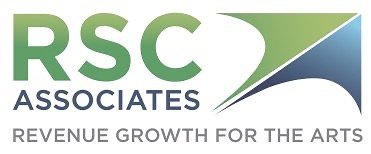EXPANDING THE ANNUAL FUND DONOR BASE
With Bob Swaney
It’s time to address a crucial aspect of sustaining arts and cultural organizations – expanding the annual fund donor base. In this ever-evolving landscape, it's essential to grow the donor base to meet the challenges and opportunities of fundraising in the arts sector. It's also becoming increasingly difficult. Organizations are facing economic uncertainties, shifting donor priorities, and increased competition for donor attention and the donor dollar.
Despite these obstacles, there are strategies and best practices that can help. Let’s look at some key best practices to attract and retain donors so that you can effectively expand your annual fund donor base.
Read the full transcript below or click the button to listen.
FULL TRANSCRIPT OF THE PODCAST
Today we're going to address a crucial aspect of sustaining arts and cultural organizations – expanding our annual fund donor base. In this ever-evolving landscape it's essential to grow the donor base to meet the challenges and the opportunities of fundraising in the arts sector, but it's also becoming increasingly difficult.
Let's start by acknowledging just some of the hurdles that we face. There are:
Economic uncertainties
Shifting donor priorities
Increased competition for the donor dollar and for donor attention
Those are just a few of the things that are inhibiting, or putting at risk, growth.
Moreover, many arts organizations are experiencing a decrease in attendance or participation from the public, which in turn limits the best pool of prospects for donors. The normal wells to which fundraisers go to get the water are starting to dry up, or at best require a longer rope to get the water out of the well.
Despite these obstacles though, there are strategies and best practices that can help you. Today we’ll look at five key best practices to attract and retain donors so that you can effectively expand your annual fund donor base.
Best Practices to Attract and Retain Donors
#1: Focus on your consumers.
Although your arts organization's base of attendees or visitors might have changed in the past seven to ten years, this group remains your best source for new donors.
Don't ignore it, and don't wait too long. There's conventional wisdom that says that fundraising needs to be patient. That our consumers need to come two, three, four, ten times. They need to visit the museum or our performing arts center many times over the course of two to three years. Then, and only then, can fundraising begin to approach them. I don't agree with that conventional wisdom. It doesn't work.
It takes way too long when you look at the normal patron lifespan which might only be three or four years with an institution. That is, unless you infuse annual giving into that. Giving will usually double a patron’s lifespan, so they stay as patrons for six to ten or more years, in part because they make a gift on top of their attendance.
Expanding a consumer's viewpoint to include the mission driven support that you're asking for does not discourage and it does not dampen that consumer's desire to personally enjoy what you have to offer. I know there's a fear that the patron only has so much money, and if they decide to give it, then they won't use it to spend to come. I just haven't seen the evidence to support that and I certainly haven't experienced it first-hand. People who attend really get to like you as an institution and once they start giving, they begin to love you as an institution. And once they love you, they're going to continue to do the things that you need them to do and interact in both attendance and giving.
#2: Segment and personalize.
If you understand that different donors respond to different channels of information, you're way ahead.
Having complete clean data is important because you'll want to segment those donors and your prospects with their giving history, their purchase history, their interests, their demographics, whatever you have available that can help you make decisions for segmentation.
You should have segments set up in such a way that you can personalize your appeal in ways that appeal to each kind of donor. Segmentation allows you to tailor the communication to foster a sense of connectivity, some appreciation. Segmentation lets you do it in the right time frame, with the right frequency.
#3: Use storytelling and impactful communications.
Did you know that people generally give for one of three reasons? People give for what it does for:
the organization
the community
them personally as a donor
When you look at your annual fund, we need to create stories that connect with these reasons.
As fundraisers, we recognize good storytelling helps build good relationships. Compelling stories that illustrate the impact of your organization's work is one thing. But you can use stories to talk about donor benefits, because that appeals to a different kind of donor. Talking about how active you are in the community appeals to a certain kind of donor. We can touch on all three of those through storytelling and thoughtful, impactful communication.
#4: Build relationships beyond transactions.
Focus on cultivating long-term relationships with your prospects and donors, even those at lower levels, like under $500. You won’t be able to spend one on one time with every single donor, but you can create an environment of appreciation that extends to all donors and all prospective donors, even at the broad-base level. Through post-concert events or exhibit openings we can create experiences that feel exclusive and special for the broad-base donor. Consider how you can invest in your patron base, in terms of time, resources, communications. Look for opportunities to share your mission in different environments with them.
Relationship building doesn't always have to be one on one. It can also mean small group or large group. Because different people respond differently, your stewardship program and relationship building should include a variety of approaches, in uncomplicated and inexpensive ways.
#5: Be transparent on how donor contributions are used within your organization.
I was preparing for a meeting with an organization recently and went online to read their 2023 annual report. I was blown away. It was beautiful. It had the right balance of statistics and information. It was clear that transparency and accountability are important to them. But it was also clear that this was just one step for them in their donor communications.
Regular updates on projects and programs, what the organization is involved with, recent wins. Communicating these builds trust and confidence. And if you can use transparency and accountability to build trust and confidence in your organization, it really helps donors invest in you, repeatedly and for the long-term.
#6: Learn and adapt continuously.
Stay informed about emerging trends and the donor preferences, not just the trends about your organization or industry. As we all learned in the last four or five years, donor preferences have changed and they're going to continue to change.
Listen to your donors on which experiences, communications, donor benefits or membership benefits they like. You can uses surveys, but don’t limit your listening to them. You can also ask opinions in one on one conversations and during small events. In your cultivation and stewardship conversations it's okay to go equipped with some questions that help you determine what's working and what's not.
Practices to Avoid
In like fashion, then I'll talk about practices to avoid.
#1: Overlook donor retention.
People so often say “we need more donors, we need more donors, we need more donors.” And while I agree with that, you don't just need more donors. You need to keep more donors.
Keeping more donors is just as important, if not more important, than acquiring donors. Donor attrition rates will kill your fundraising efforts for growth. Don't prioritize acquiring new donors at the expense of neglecting existing donors. Invest in stewardship efforts to retain those donors and foster long-term loyalty.
An example. Let's say that your historical attrition on your donor base is 25%. If you could decrease that by 2% and you did that every year for five years, think about how much in terms of money that translates into over that five-year period.
Plus, once a donor leaves, they're a lot harder to get back. In some cases, they're harder to get back than they were to get the first time.
#2: Transactional approaches.
Avoid treating donors as mere transactions. In today's world, it can be really easy to do because so many of the introductory transactions happen online. But again, build meaningful relationships by engaging those donors in meaningful ways beyond just the solicitation.
For example, if you give online, you often get a thank you email right away. That makes many people feel good. But for me personally, I strongly dislike it. Similarly, when I received a thank you letter in the mail and it includes another ask for support, it really bothers me.
Here's why. Automated digital thank you’s and asks in thank you letters reinforce a transactional mindset and leaves donors feeling like the gift just made wasn't enough. There are times when you need to thank to thank, and times when you give information just to give information. When instead you send another ask along with a thank you, you lose the human element. It becomes too transactional and it avoids building relationship.
#3: Ignore donor feedback.
We should be asking good questions and listening very closely. Actively seeking and responding to donor feedback is something that we often don't get right.
Ask and listen to donors, and then incorporate the suggestions, addressing their concerns to demonstrate responsiveness and commitment. Don't let it be just lip service. Do it with heartfelt intent.
And then circle back around and give donors an update. You can say that you appreciate them saying that, explain what your organization did, and ask what they think.
That's how you build true relationships. If a donor is going to go to the effort of telling you something they don't like, about an idea that they have, or something you could change, you shouldn't ignore it.
#4: Lack of diversification.
Don't rely too heavily on a single funding source or donor segment. For that matter, don't rely too much on a single donor. It's really risky to do such a thing.
Instead, diversify your donor base. That mitigates the risks that come with depending on a few sources, and it helps you explore alternative fundraising opportunities and sources that you might otherwise miss. A healthy donor pyramid with donors at all levels is key not just for the short term, but for the long term for your fundraising program success.
While we talked earlier about the importance of retaining donors, and new donor acquisition is still important and can help diversify your donor base. It can be expensive, but it's not as expensive as eventually losing one of those big donors without a plan to replace those dollars.
#5: Fail to adapt to technology.
I've been in fundraising for 40 years, and it's not always easy to embrace technology. But technology can help us streamline processes and enhance the donor experience and relationship. Investing in digital fundraising platforms and training staff to leverage technology effectively is monumentally important moving forward.
This does not mean we should replace longstanding best practices that remain effective. But you can use best practices AND use technology, especially as an enhancement.
In closing:
Growing your donor base is going to take investment and willingness to change, but by implementing these best practices and avoiding common pitfalls, we can effectively expand our donor bases and ensure the long-term sustainability of our arts and cultural organizations.
And if you remember just one thing, make it this. To successfully expand the donor base, adopt the mindset of getting donors, keeping donors, and increasing donors every single day.



